In two weeks, a celestial celebration will occur across the United States as a total solar eclipse sweeps the land, from the Rio Grande Valley of Texas, through the Champlain Valley in Vermont.
You may be wondering; didn’t this happen in 2017? It did. But the maximum width of the 2017 eclipse was roughly 65 miles wide, because the Moon was a bit farther away from the Earth than the upcoming April eclipse. In April, the path will range from 108-122 miles wide – meaning the eclipse will cover more ground.
The 2024 solar eclipse will not only be wider, but will cover more densely populated areas, where an estimated 31 million people will be in the path of totality. That’s nearly double the amount of 2017’s path of totality, at nearly 12 million people.
Get Boston local news, weather forecasts, lifestyle and entertainment stories to your inbox. Sign up for NBC Boston’s newsletters.
Totality will last longer too. In 2017, the longest period of totality was 2 minutes and 42 seconds—in Carbondale, Illinois. For the upcoming eclipse between Texas and Indiana, totality will last nearly 4 minutes.
PLANETARY PLAY-BY-PLAY
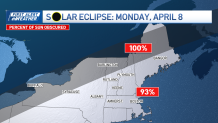
While Boston won’t be in the path of totality, there will still be good viewing - 93% of the sun will be covered by the moon, turning the daylight to darkness.
Weather Stories
BOSTON
2:16 p.m.—Partial Eclipse Begins - this first contact- the moment the edge of the Moon touches the edge of the sun. You’ll need to put on eclipse glasses as the eclipse starts to become visible.
2:38 p.m.—20% Obscuration—a fifth of the area of the Sun’s disk is covered by the Moon
2:45 p.m.—Temperature changes—as the Moon covers the sun, radiation from the sun decreases.
3:00 p.m.—The sun becomes noticeably darker
3:07 p.m.—Meteorological conditions change—temperature, humidity and wind, continually altered because solar energy decreases.
3:23 p.m.—Nature Knows—this is the point that with the loss of daylight, animals behave differently, and plants start to be affected.
3:29 p.m.—Maximum Eclipse—this is the deepest point of the eclipse, as the sun is its most hidden. In other regions in totality, the sun will be totally covered. ONLY in totality is it safe to take off eclipse glasses. This period lasts for nearly 3-4 minutes depending on region.
3:35 p.m.—Nature Reacts—as the sun peeks back out, nature begins to return to normal.
3:51 p.m.—Temperature Returns—sky conditions and surrounds are returning to normal daytime parameters, including temperature.
4:19 p.m.—20% Obscuration—a fifth of the area of the Sun’s disk is covered by the Moon
4:39 p.m.—Partial Eclipse Ends—as the moon’s edge leaves the edge of the sun.
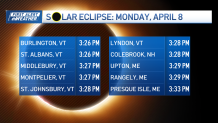
BURLINGTON
2:14 p.m.—Partial eclipse begins—The moment the edge of the moon touches the edge of the sun.
2:36 p.m.—Obscuration around 20%—One-fifth of the area of the Sun's disk is covered by the moon.
2:43 p.m.—Temperature changes—As the moon covers the sun, the amount of solar energy decreases.
2:57 p.m.—the brightness of the sky—as the eclipse progresses, the sky becomes noticeably darker.
3:18 p.m.— the reaction of nature—The behavior of animals and plants starts to be affected by falling levels of light.
3:25 p.m. – The corona, or the outer part of the sun's atmosphere, becomes visible and forms a ring around the moon. This is known as the diamond ring.
3:26 p.m. – TOTALITY BEGINS the edge of the moon covers all of the sun. A red layer of the sun's atmosphere is briefly visible.
3:27 p.m. – Maximum eclipse, the deepest point of the eclipse occurs with the sun mostly hidden. In other regions in totality, the sun will be totally covered. ONLY in totality is it safe to take off eclipse glasses. This period lasts for nearly 3-4 minutes depending on region.
3:29 p.m. – TOTALITY ENDS just before the end of totality; the chromosphere briefly reappears. Then the moon exposes the sun.
3:29 p.m. – Dark shadow sweeps out; the moon's umbral shadow moves east.
3:36 p.m. – Nature returns to normal. Animals return to usual behavior.
3:50 p.m. – light levels and temperatures, the conditions of the sky and surroundings return to normal.
4:37 p.m. – partial eclipse ends, the edge of the moon leaves the edge of the sun.
CLOUDING YOUR VISION
The million-dollar question is, how cloudy will New England get on April 8? Historically, Boston has been cloudy on this day 61% of the time (since 2000) and Burlington, Vt., this day has been cloudy 69% of the time. Though last year there were clear to mostly clear conditions.
While longer range forecasting doesn’t carry the highest level of confidence, the trends are to at the very least have partly cloudy skies.
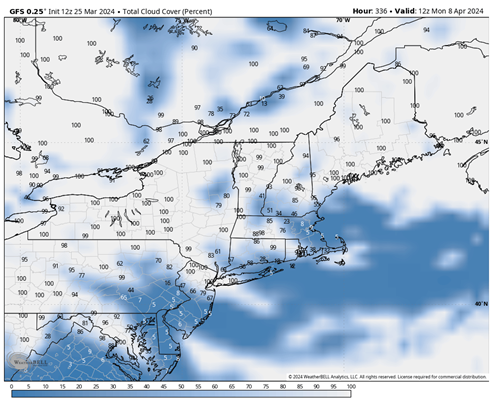
Monday morning, clouds are breaking across Southern New England.
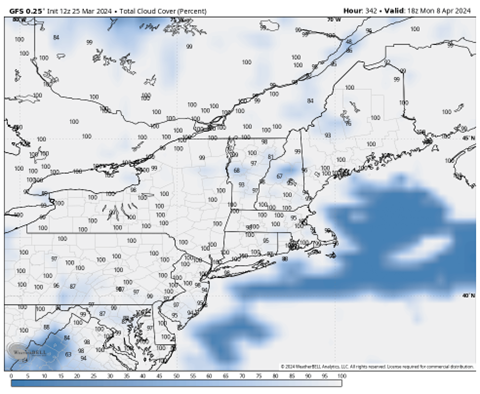
Monday afternoon clouds build up for much of New England
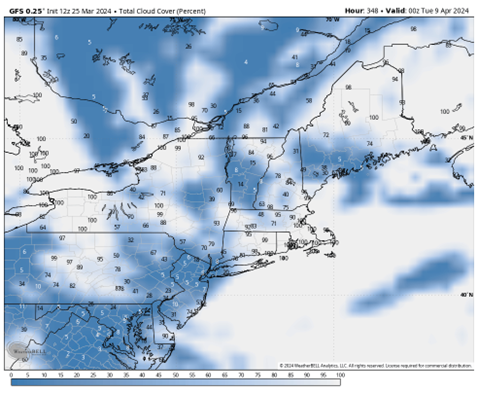
Monday night clouds are breaking apart through Northern New England.



